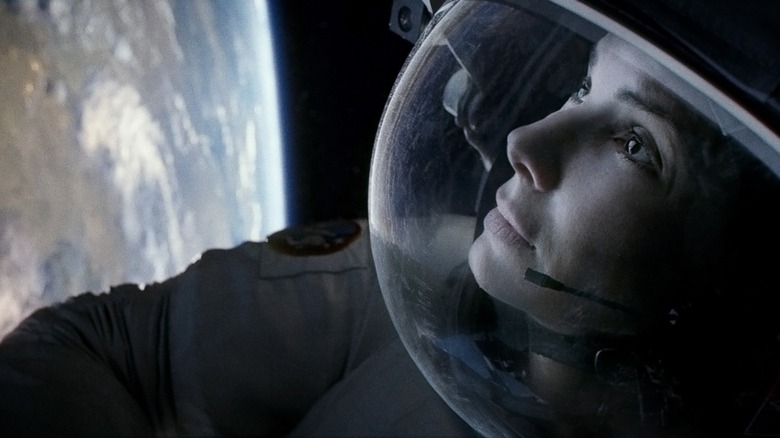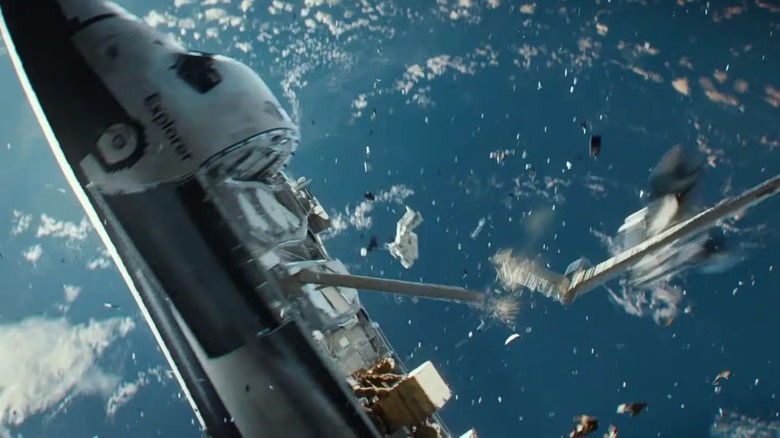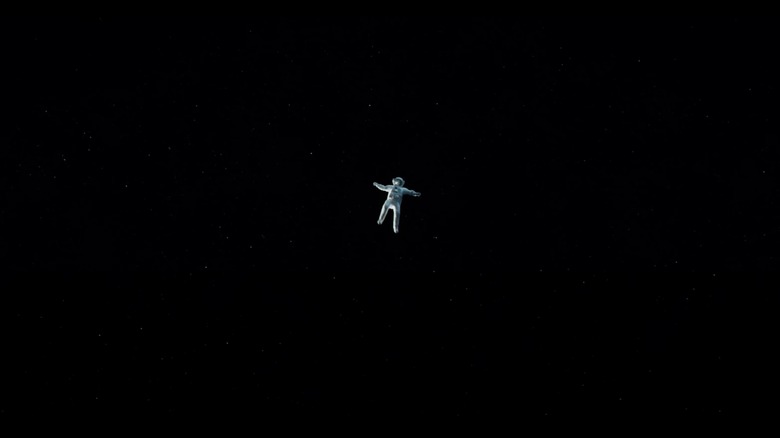The Opening Oner In Gravity Is The Best Action Scene Ever
(Welcome to Best Action Scene Ever, a column dedicated to breaking down the best, most effective action sequences throughout the genre. In this edition, we revisit the groundbreaking triumph of Alfonso Cuarón's "Gravity" and the adrenaline-pumping thrills of that opening one-shot sequence.)
Space is where things go to die. Whether it's literal stars going supernova, another of Elon Musk's Space-X rockets experiencing a "rapid unscheduled disassembly," or poor George Clooney on his last-ever mission to the International Space Station, the seemingly infinite vacuum surrounding our planet and the rest of the entire known universe is as inhospitable as environments get. So the fact that humanity keeps encroaching on this final frontier despite the mind-melting risks either speaks to our relentless industriousness as a species ... or our unparalleled pigheadedness. What "Gravity" suggests is: What if it were both?
Director Alfonso Cuarón's 2013 masterpiece is easy to praise as a technological marvel, seamlessly recreating the sheer beauty and the unquantifiable terror of space in equal measure. But more than merely functioning as a feature-length tech-demo, "Gravity" rightfully earned each and every one of its 10 Academy Award nominations (and eight total wins) by integrating cutting-edge innovation in visual effects with a whip-smart script that never once lost sight of how to combine spectacle with story. That much was clear right from the opening moments of the film, which unfolds as a single unbroken take digitally stitched together over the course of over 13 exhausting, nerve-wracking minutes.
All the while, Cuarón feeds us everything we need to know about Sandra Bullock's rookie astronaut Ryan Stone, Clooney's grizzled veteran Matt Kowalski, and the dire straits they find themselves in when a Russian missile destroys its own rogue satellite (remember what I said about pigheadedness?) and unleashes disaster upon the NASA crew.
The scene
I can still remember the awed gasps from audiences ten years ago when "Gravity" cut from the opening title cards to the indescribably stunning vista of Earth from orbit. Slowly, while all our attention is focused on the vibrant greens and blues of our home planet, a pinprick of light separates itself from the background of stars and comes into focus as a space shuttle in orbit around Earth. Sent on a mission to perform repairs on the Hubble telescope, astronauts Kowalski and Stone quickly introduce themselves in wildly different ways; the carefree Kowalski jetting around effortlessly in his jetpack as he takes in the sights, and Stone fighting off nausea as she struggles to perform her (relatively) simple task. The astronauts' light banter with mission control makes great use of shorthand to convey exactly how different these characters are, and, by extension, how well-prepared they may or may not be once things start to go sideways.
And boy, do things fall apart very quickly. With only a few ominous warnings of Russian military activity on the far side of the planet, Emmanuel Lubezki's cinematography (bolstered by some of the greatest VFX work you'll ever see, primarily by the folks at Framestore) and Steven Price's propulsive original score do the heavy-lifting to raise viewers' heart rates once NASA takes on a much more alarmed tone at the cascading debris field now threatening the shuttle. With our astronauts caught in the open and woefully unprepared for the threat about to reach them, all we can do is sit back and watch helplessly — with the illusion of a single take only further contributing to our (and Ryan's) utter lack of control.
Why it works
By rights, it shouldn't work. Countless filmmakers before have tried the one-shot technique and utterly failed, treating it like a showy gimmick rather than a tool in service of maximizing drama. But not just any scene benefits from such a technique. Luckily, Cuarón innately understood how much heavy lifting the first several minutes of "Gravity" needed to accomplish. Tasked with plunging audiences headfirst into an alien environment with completely different rules (both cinematically and in terms of actual physics), the talented filmmaker realized early on that the best way to communicate all this information would be through a oner ... or the impression of one, at least.
That's what makes the rest of the scene fall into place. Once the tenor of the scene changes dramatically and the urgency kicks in (thanks largely to Ed Harris' unseen but crucial narration from mission control, relaying NASA's concerns as the mission and the astronauts' lives are placed in jeopardy), the very movement of the camera soaking in all the action — until this point, serving as a passive, documentary-like observer — flips on a dime once the defunct and out-of-control satellite whizzes by at nearly incomprehensible speeds. Suddenly, the camera's omniscient ability to capture such serene vistas turns from expansive to suffocatingly restrictive as it's physically unable to keep up with the flying debris headed right for the shuttle. Every moment spent following Kowalski as he attempts to retrieve Stone means another second we're unable to look out for the danger headed right for them.
This unbearable tension continues to mount as the shuttle — and Stone's very reality — explodes right out from under them. Now locked into Stone's perspective, the dizzying action reaches its chaotic peak. And as she spins off into space, the scene finally cuts.
The key moment
The moment Cuarón decides to end the one-shot, the impact it has on audiences is immediate. Finally allowed to take the deep breath that most had unconsciously been holding, we're reoriented and ever-so-briefly able to get our bearings. There aren't exactly many signposts or landmarks in space, so the film smartly cuts back to Earth with Stone tumbling in the foreground — away from the destroyed shuttle and from any hope of rescue.
But what often gets lost in the hype of the initial one-shot sequence is the fact that the film immediately transitions into another one centered exclusively on Stone. As Kowalski desperately pleads with her over the radio to report her position, Cuarón and Lubezki heighten her fear by locking the camera onto her helmet as she tumbles uncontrollably and at a stomach-churning rate. Where they mostly relied on spectacle to this point, we're now thrust right into Stone's helmet along with her in the most intimate of the movie's perspectives. Now in the shadow of the Earth, most viewers were likely too caught up in the action to even notice the dramatically shifted lighting. What once felt like a comforting and mundane mission in broad daylight now takes on a much more sinister aura in the depths of space, tempered only by Kowalski's arrival. After managing to find Stone and tether themselves together, they make their way back to the ruined shuttle to take stock of their situation.
Although "Gravity" still relies on an abundance of longer shots throughout the rest of its runtime, there's no denying the power of these early ones to help set the tone. Part roller coaster, part IMAX documentary, and part survival tale, "Gravity" has its opening oner to thank for teeing up the rest of the thrills to come.


